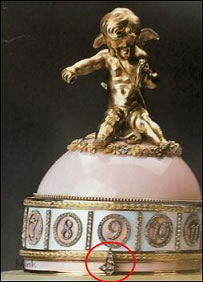1910 Colonnade Egg
Gift
Nicholas II to Alexandra Feodorovna
Made in Saint Petersburg
Owner: HM Queen Elizabeth II, England
Height: 28,6 cm
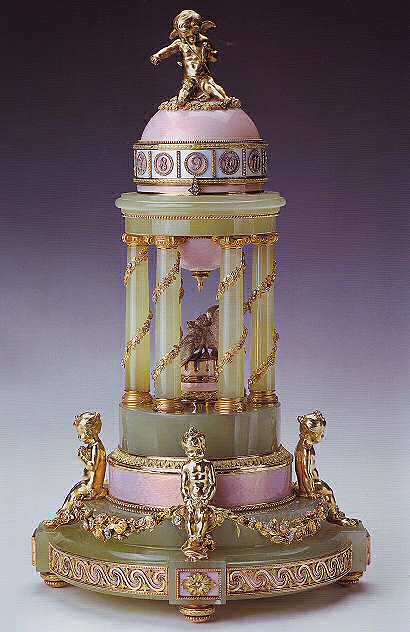
The 1910 Colonnade Egg is made of bowenite, quatre-couleur gold, rose-cut diamonds, silver-gilt, platinum, pale pink and white enamel.
Designed as a temple of love, this clock egg commemorates the birth of the long awaited heir to the throne, Alexei, in 1904. A silver-gilt cupid, a representation of the tsarevich, surmounts the gold Egg, which is enameled in opalescent pale pink and is encircled by a broad band of a white enameled dial, set with rose-cut diamond numerals. The little gold cupid originally had a twig in his hands that pointed the the our. Four silver-gilt figures, representing the Tsar's four daughters, are seated around the base and are linked by floral swags in quatre-couleur gold. Two platinum doves are perched within the circle of the columns.
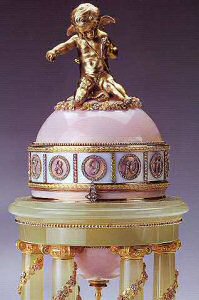
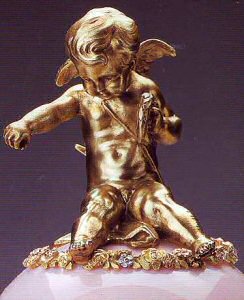
Background information
There has been confusion for a long time, over whether the Colonnade Egg was the companion piece for the 1907 Love Trophies Egg, as both Eggs were thought to celebrate the birth of the heir. Research however indicates that this Egg was presented to Empress Alexandra in 1910.
The Colonnade Egg demonstrates how important the birth of the Tsarevich was to the Romanov Dynasty. After the dead of his mother, Catherine the Great, Tsar Paul I decreed that women could no longer inherit the throne. Had the Imperial couple failed in having a son, Nicholas' younger brother Michael would have become Tsar.
In 1927 the Egg was one of the nine sold by the Antikvariat
to Emanuel Snowman of Wartski in London. In 1929 (see update) 1931 sold to Queen
Mary, UK. 1953 inherited by Queen Elizabeth
II.
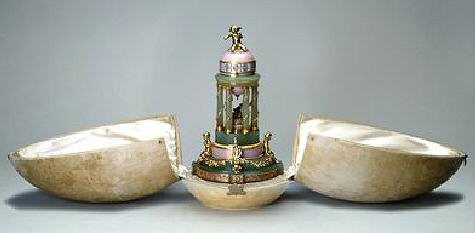
The 1910 Colonnade Egg: A Possible Source Is Proposed - by Geoffrey Munn - See for the article, the Fabergé Research Newsletter, Summer 2013.
The 1910 Colonnade Egg - another possible inspiration by Peter Koppers
In December 2011 Peter Koppers from The Netherlands visited The Château de Malmaison near Paris, formerly the residence of Joséphine de Beauharnais, first wife of Napoleon I, and thus the first Empress of the French. In the palace Peter noticed a clock he thought could well have served as inspiration to Fabergé. Below right, another clock in the same style.
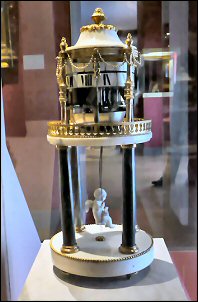

Left, Château de Malmaison Clock © Photo Peter Koppers.
Another late 18th century
Louis XVI "Pendule a Cercles Tournants" made in Paris was sold at Christies in 2006. (Courtesy Christies)
Update July 2019
Geoffrey Munn in his 2015 book, Wartski, the First One Hundred and Fifty Years, writes on page 60 that:
"the strongest evidence the 1910 Colonnade Egg was once at Wartski, comes from Queen Mary herself, as in her own copy of Henry Bainbridge's 1949 Peter Carl Fabergé - His Life and Work, she recorded that she acquired the Colonnade Egg from Emanuel Snowman and gave it to her husband, King George V, in 1931".
Less is more?
The cupid on top of the egg originally held a twig or arrow in his hands pointing to the hour as you can see below in the original early Faberge photograph [1]. Henry Bainbridge in his 1949 book Peter Carl Faberge [2] shows the Egg, while in the Royal Collection, with the cupid holding what looks to be a flower and a (new) arrow mounted on the circular dial, pointing at the hour. The image on the right is of the Egg as it is today, shown on the website of the Royal Collection [3].
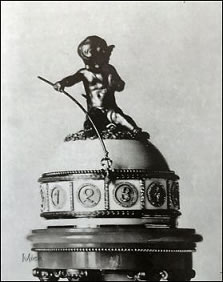
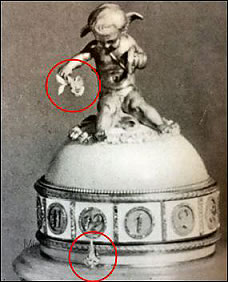
Left to right, Early Fabergé photograph [1] Photograph ca. 1949 [2] Photograph Royal Collection 2019 [3]
Some time ago I had the opportunity to ask the senior curator of the Royal Collection why they had not recreated the original twig, or arrow, to restore the egg to its original state. The curator answered that they had thought about it but decided to show the egg the way it was when it entered the collection of Queen Mary, now the Royal Collection Trust / © Her Majesty Queen Elizabeth II.
Notes
All images of the Colonnade Egg courtesy of and copyright to the Royal Collection Trust / © Her Majesty Queen Elizabeth II 2019
[1] Tatiana Fabergé, L. Proler, V. Skurlov, The Fabergé Imperial Easter Eggs, 1997, page 196.
[2] Henry Charles Bainbridge, Peter Carl Faberge Goldsmith and Jeweller to the Russian Imperial Court and the principal Crowned Heads of Europe, (first published) 1949, Plate 61
[3] Website of the Royal Collection: https://www.rct.uk/collection/40084/colonnade-egg (retrieved July 2019)
![]() This Egg is one of the "Clock Eggs". Here you can see them all together
This Egg is one of the "Clock Eggs". Here you can see them all together
Page updated: September 3, 2020

